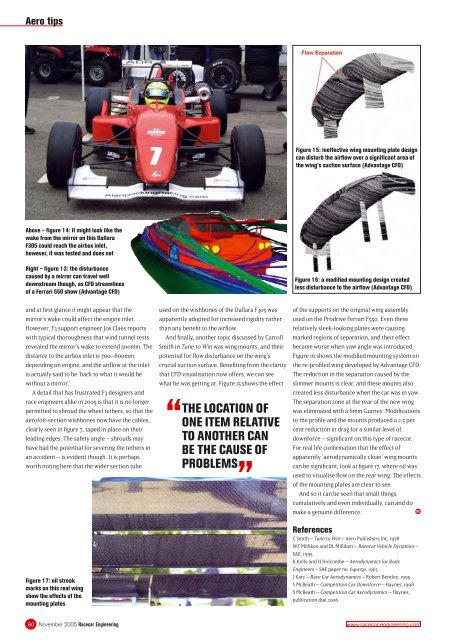Racecar Engineering - November 2005
Racecar Engineering - November 2005
Racecar Engineering - November 2005
You also want an ePaper? Increase the reach of your titles
YUMPU automatically turns print PDFs into web optimized ePapers that Google loves.
Aero tips<br />
Figure 15: ineffective wing mounting plate design<br />
can disturb the airflow over a significant area of<br />
the wing’s suction surface (Advantage CFD)<br />
Above – figure 14: it might look like the<br />
wake from the mirror on this Dallara<br />
F305 could reach the airbox inlet,<br />
however, it was tested and does not<br />
Right – figure 13: the disturbance<br />
caused by a mirror can travel well<br />
downstream though, as CFD streamlines<br />
of a Ferrari 550 show (Advantage CFD)<br />
and at first glance it might appear that the<br />
mirror’s wake could affect the engine inlet.<br />
However, F3 support engineer Jos Claes reports<br />
with typical thoroughness that wind tunnel tests<br />
revealed the mirror’s wake to extend 500mm. The<br />
distance to the airbox inlet is 700–800mm,<br />
depending on engine, and the airflow at the inlet<br />
is actually said to be ‘back to what it would be<br />
without a mirror.’<br />
A detail that has frustrated F3 designers and<br />
race engineers alike in <strong>2005</strong> is that it is no longer<br />
permitted to shroud the wheel tethers, so that the<br />
aerofoil-section wishbones now have the cables,<br />
clearly seen in figure 7, taped in place on their<br />
leading edges. The safety angle – shrouds may<br />
have had the potential for severing the tethers in<br />
an accident – is evident though. It is perhaps<br />
worth noting here that the wider section tube<br />
Figure 17: oil streak<br />
marks on this real wing<br />
show the effects of the<br />
mounting plates<br />
used on the wishbones of the Dallara F305 was<br />
apparently adopted for increased rigidity rather<br />
than any benefit to the airflow.<br />
And finally, another topic discussed by Carroll<br />
Smith in Tune to Win was wing mounts, and their<br />
potential for flow disturbance on the wing’s<br />
crucial suction surface. Benefiting from the clarity<br />
that CFD visualisation now offers, we can see<br />
what he was getting at. Figure 15 shows the effect<br />
“<br />
THE LOCATION OF<br />
ONE ITEM RELATIVE<br />
TO ANOTHER CAN<br />
BE THE CAUSE OF<br />
PROBLEMS<br />
”<br />
Figure 16: a modified mounting design created<br />
less disturbance to the airflow (Advantage CFD)<br />
of the supports on the original wing assembly<br />
used on the Prodrive Ferrari F550. Even these<br />
relatively sleek-looking plates were causing<br />
marked regions of separation, and their effect<br />
became worse when yaw angle was introduced.<br />
Figure 16 shows the modified mounting system on<br />
the re-profiled wing developed by Advantage CFD.<br />
The reduction in the separation caused by the<br />
slimmer mounts is clear, and these mounts also<br />
created less disturbance when the car was in yaw.<br />
The separation zone at the rear of the new wing<br />
was eliminated with a 6mm Gurney. Modifications<br />
to the profile and the mounts produced a 2.5 per<br />
cent reduction in drag for a similar level of<br />
downforce – significant on this type of racecar.<br />
For real life confirmation that the effect of<br />
apparently ‘aerodynamically clean’ wing mounts<br />
can be significant, look at figure 17, where oil was<br />
used to visualise flow on the rear wing. The effects<br />
of the mounting plates are clear to see.<br />
And so it can be seen that small things,<br />
cumulatively and even individually, can and do<br />
make a genuine difference.<br />
RE<br />
References<br />
C Smith – Tune to Win – Aero Publishers Inc, 1978<br />
WF Milliken and DL Milliken – <strong>Racecar</strong> Vehicle Dynamics –<br />
SAE, 1995<br />
K Kelly and H Holcombe – Aerodynamics for Body<br />
Engineers – SAE paper no. 640050, 1963<br />
J Katz – Race Car Aerodynamics – Robert Bentley, 1995<br />
S McBeath – Competition Car Downforce – Haynes, 1998<br />
S McBeath – Competition Car Aerodynamics – Haynes,<br />
publication due 2006<br />
60 <strong>November</strong> <strong>2005</strong> <strong>Racecar</strong> <strong>Engineering</strong><br />
www.racecar-engineering.com

















